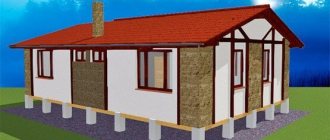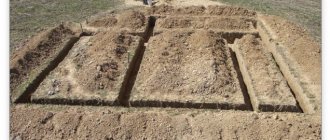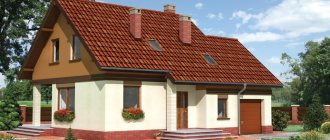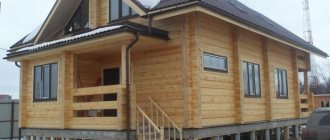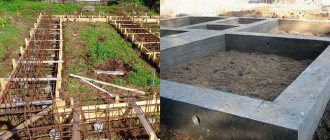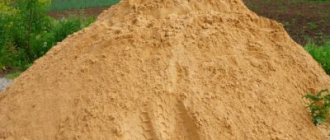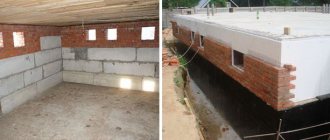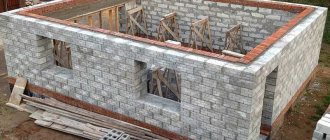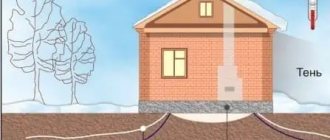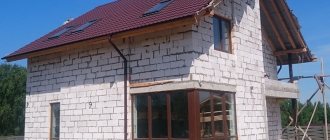Factors influencing choice
The depth of laying the foundation for a two-story house made of foam blocks depends on the level of groundwater in relation to the soil surface.
The level of such waters is determined by special studies. In order to save money, you can check this information with your neighbors, who will tell you with what frequency and intensity their basements and plots are flooded with water.
The freezing point of the soil composition also matters, the depth of which varies from fifty centimeters to two meters. This factor has a direct impact on the choice of the depth level of the foundation for a two-story foam block house, but most often its influence is indirect, and the manifestation indicator is determined by the characteristics of the soil composition. If the soil is not heaving, then nothing threatens the foundation even at great freezing depths.
When choosing a foundation option, it is necessary to take into account the soil characteristics at the construction site. On rocky and coarse soils, it is recommended to erect strip foundations in the shape of the letter “T”
It is allowed to use a slab foundation laid at a shallow depth. If construction is planned in fragile, loose areas, a two-story building that has significant weight should not be installed on a pile foundation. In this case, a slab foundation is suitable, under which a sand-crushed stone layer is placed
On rocky and coarse soils, it is recommended to erect strip foundations in the shape of the letter “T”. It is allowed to use a slab foundation laid at a shallow depth. If construction is planned in fragile, loose areas, a two-story building that has significant weight should not be installed on a pile foundation. In this case, a slab foundation is suitable, under which a sand-crushed stone layer is placed.
On soils that are excessively saturated with moisture, strip and slab foundations that have a drainage system and a waterproofing protective layer work well.
Foundation for a house made of foam blocks: selection criteria, features of pouring
Added by: Elena Kovtun August 3
Houses made of foam blocks are becoming quite popular, due to the speed of wall construction, high performance characteristics and low material costs. But already at the beginning of construction, most people are faced with the problem of choosing the optimal foundation option for a house made of foam blocks.
Calculation of load characteristics of the base
The function of the foundation is to take on the loads that create the structure of the structure, distribute them and transfer them to the ground. It protects the house from deformations that cause cracks and other destructive processes that shorten the life of the building. Therefore, before starting work, you need to make a calculation of the foundation for a foam block house. It depends on the following main factors:
- individual layout of the future home,
- terrain,
- groundwater level,
- climate features in the region,
- wall and ceiling materials,
- level of operational loads,
- bearing capacity of the soil,
- lag layout diagrams,
- roof slope angle.
Before starting the construction of a foam block house, you must:
- Carry out a geological and engineering survey of the area.
- Determine the loads that will be created by the house structure when there is pressure on the foundation.
- Select the type of foundation and building material from which it will be made.
- Determine the depth of the foundation.
Method for calculating the foundation based on maximum strength characteristics
Sometimes a situation may arise when some parameters cannot be determined. In this case, the strength qualities of the foundation, which are obviously overestimated, must be included in the calculations, or reinforcement must be made through the use of different types of foundation. For example, for a screw foundation, the number of piles is increased, a concrete grillage and columnar supports are combined together.
The strength and durability of any structure depends on a properly constructed foundation, so it is best to entrust the selection of the foundation for a building made of foam blocks to specialists.
Laying the foundation
The depth of laying the concrete foundation for a house made of foam blocks plays an important role. The entire system of load-bearing concrete structures has considerable weight. Monolithic casting (frame) of the future house is made of class B-26 concrete.
The main weight of a two-story house falls on the monolith. The entire load falls on the monolithic frame and grillage. The walls are self-supporting structures; foam concrete is simply placed in the openings. Therefore, the optimal laying depth for a house made of foam blocks in normal soils will be minus 2200 mm from the zero level of the project. But this is for the middle zone. In each case, the depth will be different; when building a two-story building, you need support with the installation of special load-bearing pillars or pillows (glasses).
How to check the soil under the foundation yourself
Checking soil by color Drilling test wells.
By drilling a small shaft 1-2 meters deep, you can visually determine some of the qualities of the soil. You can also dig a small pit, thereby determining the location of the load-bearing layer of soil, loam or clay. But this is all relative; if analysis is impossible, a reinforced foundation is laid on piles or concrete pillars. Direct factors, such as the presence of water, sand particles and stones, will prompt the choice and direction. But they do not cancel the need to do an analysis.
Of course, in most cases of construction of country houses, few people conduct such an analysis. Then it is recommended to develop the trench to a dense load-bearing layer. Here we will analyze more precisely all the stages, both for a one-story house and for a two-story one.
Characteristics of foam blocks
Foam block, which has been used since the 70s, has proven itself well thanks to the following characteristics:
- Good frost resistance is the quality most suitable for our latitudes;
- Safety - the material is non-toxic in case of fire and does not burn well;
- Low thermal conductivity - and this, unlike the first point, will allow you to retain heat inside;
- A good and clear shape of the “bricks” will allow you to make fewer seams when laying, and they will be much thinner than ordinary bricks;
- Ease of additional processing - the blocks are easily sawed and drilled with conventional tools (hacksaw or drill);
- Fast construction - again, due to the size of the blocks, time costs are significantly less;
- Sufficient soundproofing properties - useful in a home, even a private one.
Special attention should be paid to the following points:
- When creating masonry, it will need to be reinforced (to give additional rigidity to the structure);
- The material is not intended for multi-level construction, the limit is 2-3 floors;
Two floors is the optimal load on foam blocks Source nauka-i-religia.ru
- It absorbs moisture well due to its structure, so it is better to additionally protect buildings made of foam concrete with canopies and facades;
- It is better to lay walls at a temperature of at least +5 degrees;
- It is best to transport and store the material in plastic film; during storage, you also need to use a room (or a canopy).
Technologies and construction time
The cheapest arrangement option. For such a base, a flat area with water depths of 2 m or more is suitable. Trenches can be dug manually to a depth of only 0.5 m. The height difference is checked with a water level. The width of the tape should be 10 cm larger than the future walls.
A cushion of sand and gravel (crushed stone) is formed at the bottom of the trench. The sand and gravel base of the foundation must be well compacted to prevent subsidence. Next, the formwork is created and reinforcement Ø10 mm is laid. Concrete is poured in one go.
The foundation must stand for at least 10 days, only after that can you begin laying the walls. But it is better if the foundation hardens for the required 28 days (4 weeks).
Well suited for a house with a basement. Compared to the previous type, it requires more consumables. Otherwise, the arrangement technologies are very similar.
It is used on clay, peaty, heaving soils, as well as when the soil freezing level is from 1.5 m. The height of the pillars must be at least 1 m and correspond to the freezing depth. Reinforced concrete supports are mounted in the corners of the building, at points of greatest load, under load-bearing walls. The standard distance between posts varies in the range of 1.5-2 m.
This option has an undeniable advantage - the shortest construction time. It is quite possible to complete all the work in 3-4 days, but provided that the height of the building is one floor. For more bulky buildings, the time frame will be increased due to the need for grillage.
It is also called a floating foundation. This type of foundation can be installed on any soil except clay. The rigidity of the structure is achieved through reinforcement. The depth of the foundation depends on the project (house with or without a basement). An important point is waterproofing. In most cases, this type of foundation is performed by a team of specialists on a turnkey basis. The disadvantages are the long hardening time and significant financial costs for materials.
A house built from foam blocks, although lightweight, requires the right foundation. In recent years, builders have decided that the best foundation on sandy soil (after slab) is a pile foundation. The piles are quickly installed. They are an excellent solution for relief areas with problematic soil.
The pile foundation for foam concrete blocks, regardless of the type of supports used (hanging, screw or rack piles), is strengthened with a grillage. Of course, this increases the cost of construction. The obligatory hiring of a team of specialists with equipment can also be considered a disadvantage.
Prices for turnkey foundation installation
By ordering a service from an organization that deals with foundations, the developer ideally receives an excellent foundation for a future house made of foam blocks. At the same time, the owner of the site does not delve into the technology, relying on the experience of professionals.
The brigade undertakes:
- site preparation;
- delivery of necessary materials;
- excavation;
- marking;
- installation and dismantling of formwork;
- reinforcement;
- concreting;
- backfill.
Companies use various methods to set prices for their services. Calculations are used per 1 m2, per 1 m3 or per 1 linear meter. Installation of piles is estimated individually; on a large site, a system of discounts is usually provided.
How much will the work of specialists cost:
Which foundation is better for a house made of foam blocks: pile, strip or monolithic
Did you like the article? Follow our channel for new ideas of useful car tips. Subscribe to us in Yandex.Zen. Subscribe.
So, we decided that our house would be built from foam blocks. It's a promising start, especially considering how much good there is to say about this material.
However, as soon as we are ready to start creating a project and calculating estimates, the question of the foundation arises.
Laying the foundation
What types of foundations are used?
The following types of foundation are distinguished:
The lowest level of any foundation is 0.5 m from the planning level. We will describe each type of foundation in detail. A columnar base is a system of pillars. The construction step is in the range from 1.2 m to 2.5 m. The pillars are installed at the most critical points - in places of maximum load of the building. The supports are combined using strapping beams. They are placed on poles. The type of base considered is used in light, stationary, non-heaving soils.
Pile foundations are chosen for soft soil, sloping and uneven terrain. It is formed using piles that are located at a distance from each other. The pile heads are connected using a beam.
The strip foundation consists of a reinforced concrete strip. It passes in those places where the load-bearing walls of the house should be. In order to determine how wide the strip foundation should be, it is necessary to know the thickness of the load-bearing walls, the area of the base and the reinforcement of the concrete. The slab base is highly durable. In this type of foundation, the slab settles by 1 - 1.2, since ground freezing occurs unevenly. Therefore, a plate that is rigid in bending is selected. In addition, it is strengthened with reinforcement.
Disadvantages of tape base
Among the disadvantages of a strip monolithic base:
- considerable material costs;
- large volumes of earthworks;
- increased labor intensity.
These disadvantages are compensated by the advantage - ease of production.
Strip foundation for a house made of foam blocks
A strip foundation is used when it is planned to build a basement under the house for storing food or various things, as well as to create a technical floor where various utilities will be installed.
The strip foundation has plenty of advantages compared to other types:
- Minimum costs. Since, in comparison with other types of foundations for houses, strip foundations require a minimum amount of materials, costs are also reduced. Therefore, this type is chosen when the budget is significantly limited;
- Simple design. It is much easier to build a strip foundation with your own hands, since special equipment or specific tools are not required to do the work well. If you study the instructions correctly and follow the advice of experts, even a person who has never been involved in construction before can cope with the task;
- Ability to withstand very high loads. Despite the minimal design, this type of base copes well with heavy loads. Therefore, buildings of several floors can be erected on it, regardless of their operational loads;
- High speed. If you mix the concrete yourself, building the foundation will take about a month. If you use special equipment or at least ordinary mixers, you will be able to cope in a week. It should be noted that the foundation must dry well before starting to build a house on it.
Unfortunately, strip foundations also have disadvantages. If the load is incorrectly calculated, its endurance and strength may not be enough. As a result, after a couple of years of operation, the house will need to be reconstructed or undergo major repairs.
Also, in some cases, it is impossible to use the type of foundation in question due to the characteristics of the soil.
The influence of soil on the foundation for a foam block house
The soil, in my opinion, has the greatest influence on the choice of foundation. The condition of the soil determines how stable it itself and the structure built on it will be.
How to determine the type of soil on the site for laying the foundation for a house
In order to determine the type of soil on your site in order to select the type of foundation to be laid, you need to hire specialists who will take samples and make a conclusion. But this procedure costs a lot of money and, as a rule, few people resort to it.
Alternatively, you can try to drill or dig several wells on the site yourself, ideally about 2 - 2.5 m deep, and analyze the soil for its composition and groundwater level.
Foundation for a house made of foam blocks on “good” soil
If the soil is slightly heaving, the groundwater level is below 2-2.5 m, and the depth of soil freezing in winter is less than 1 meter, then, as a rule, a monolithic tape for walls made of foam blocks is laid on such soil. On such good soil it is possible to construct even a shallow strip foundation.
Type of foundation on heaving soils with high groundwater level
Much more often it happens that the soil on the site is not as desired. Groundwater can be located high, and the soil itself is heaving. In this case, strip foundations, without the use of thorough drainage to remove water and moisture, become ineffective. And creating a good drainage of water from them is fraught with additional considerable costs.
On such soil, the most suitable foundation would be a monolithic slab, which can be either a slab foundation with stiffeners or an ordinary monolithic solid slab up to 0.4 m thick under the entire building.
Deep foundation on soft soils
It often happens that the upper layers of the soil are very weak, but at a depth of 1.5-2.5 m there is strong, reliable soil. Since this depth should be below the freezing depth, heaving at such a depth can therefore be neglected.
In this case, it is possible to build a deep strip foundation, the base of which is placed on dense layers of soil, but in this case, the strip foundation will still be subject to lateral heaving forces acting tangentially on its walls. Considering that a house made of foam block will be relatively light, these forces will be able to move the foundation vertically, which can adversely affect the walls.
For such soil, we need a foundation that would be simultaneously deepened to solid soil and would not be affected by tangential heaving forces.
In this case, it is possible to use a pile columnar foundation, taking into account the relatively low weight of the foam block, when laying the foundations of the piles in solid good soil to a depth of 2-2.5 m. But the use of such a foundation is ideal only for wooden houses, since it has a small base area, which is only applicable to lightweight structures that are not subject to deformation. Taking this into account, the use of a pile foundation for a house made of foam blocks must be approached with great caution, reducing the distance between the pillars to a minimum, and generally using correct and accurate calculations.
Foam block - material No. 1 for residential buildings
In the last few years, private developers have increasingly given preference to a new building material - foam blocks. Its popularity is caused, first of all, by improved sound and heat insulation qualities when compared with slag blocks or blocks from screenings. In addition, foam blocks consist of a certain number of cavities, which makes them much lighter than other materials and easier to work with.
Scheme of laying a foundation made of foam blocks.
The construction of a house from foam block has its own specifics. The first factor influencing the choice of foundation for a future home is the composition of the material itself. In the manufacture of foam blocks, a classic set of materials is used: cement and sand. Different types of material are obtained from the use of a foaming agent, which affects the strength of the finished product and its price.
Diagram of the thermal resistance coefficient of foam blocks.
When using an organic foaming agent, foam blocks are quite durable, thanks to thickened partitions between the pores, but more expensive in comparison with those in the production of which a synthetic foaming agent was used. This produces several brands of such building material, each intended for a specific type of work. Brands D100, D200, D 300, for example, are used for the construction of internal non-load-bearing partitions, D1000, D1100, D 1200 - for the construction of external walls of buildings. The rule is this: the denser the block, the greater the load it will withstand, but will lose some of its thermal insulation qualities. Therefore, blocks of the D400, D500 brands are used as thermal insulation, and D600, D700, D 800, D900 - as structural and thermal insulation material.
Work with foam blocks must begin when the air humidity does not exceed 60%, otherwise additional vapor barrier will be required, and this will be an additional expense. Directly during installation, you can replace the solution with special glue, which will create additional savings, reduce the thickness of the seams and heat loss. The blocks are ideal for architectural construction as they are easy to process.
The advantage of a house made of foam blocks
If we compare a block house with a brick one, it has several advantages. Thus, it is distinguished by good heat and sound insulation properties. In addition, walls made of foam concrete with a thickness of 0.3 m can be compared in terms of their thermal insulation properties with brick walls having a thickness of 1.0 - 1.5 m. Foam concrete is also non-flammable and is considered an environmentally friendly material.
Large block sizes help speed up the wall construction process
On the other hand, foam concrete products also have disadvantages: a higher moisture absorption coefficient than brick and fragility, depending on the lower density coefficient of the material due to the porous structure. And houses made of foam blocks require mandatory finishing and leveling of surfaces.
But all of the above are trifles compared to the affordable price and speed of construction. The main advantage is the lighter weight of the structure compared to brick . Based on these considerations, many land owners select the foundation for their future home.
How to do it?
Foam block is a durable, lightweight and reliable construction material made from cellular concrete. Therefore, houses built from foam blocks are characterized by a small static load, and for them you can choose lightweight foundation options. You can lay the foundation for the building yourself
In order for the job to be done correctly, it is important to follow all installation steps step by step and adhere to a certain sequence. Laying the foundation varies depending on its type
Strip foundation
First, you need to dig a trench no more than 50 cm deep. The soil should be dug both under future load-bearing walls and along the entire perimeter of the house. The base is made according to preliminary calculations, and it should be 10 cm wider than the walls.
A sand cushion is placed at the bottom of the trench and additionally covered with crushed stone. The thickness of each layer is approximately 10 mm. After the cushion is thoroughly compacted, the formwork is prepared and the reinforcement frame is installed. For the frame it is best to use rods with a diameter of 10 mm. Then the trench should be filled with concrete, the solution is evenly distributed over the entire working area. If construction is carried out in the summer, the concrete dries quickly. To prevent cracking, the surface should be periodically watered and covered with film.
As a rule, the construction of a house can begin 10 days after the foundation has completely dried; during this period of time, the foundation becomes strong and is ready to withstand the loads of the structure. If the groundwater level is high, then the foundation should be protected from flooding. Waterproofing in the form of hydroglass insulation or roofing felt is attached to the inside of the formwork and the formwork is given additional time to harden.
Columnar foundation
This type of foundation is chosen when a foam block house is built on soft soil consisting of loam, peat and clay. Such a foundation reliably protects the structure from freezing and soil heaving. The pillars for the base are chosen from reinforced concrete; they must be placed in areas where there are large loads, load-bearing walls and corners of the facade. The pillars are buried 1 m deep at a distance of 1.5-2 m.
For houses with 3 floors, the columnar foundation is additionally reinforced with special grillages made of reinforced concrete. The formwork in this case is distinguished by a bottom, which is supported by supports installed in the ground. After the formwork is ready, the reinforcement frame is attached to it using knitting wire and mounting loops.
Floating foundation
This foundation is suitable for all types of soil, with the only exception being clay. The base consists of monolithic slabs that can move along with the ground, protecting the walls of the structure from destruction and cracks.
To make such a foundation, you must first dig a pit with a depth of at least 60 cm under the entire area of the building, then lay a cushion consisting of a layer of sand (25 cm) and crushed stone (15 cm). After this, a reinforcing frame and waterproofing must be installed. For the frame, rods with a diameter of 8 cm are used and a step of 25 cm is maintained between them.
As for the foundation for houses whose design includes a basement, it requires special implementation technologies. The main feature of such a foundation will be its depth, so to lay it, they dig a deep pit and create a space around the perimeter of the foundation that will put pressure on the walls from the outside through the thickness of the soil.
The evenness of the trench must be checked with a laser level, after which you can fill in gravel, sand and lay waterproofing. Formwork is installed along the walls of the trench; it can be made from any building material: polymer, metal or asbestos pipes.
A metal belt made of rods with a diameter of 16 mm is mounted inside the formwork for reinforcement. The result is a cage-like structure; its walls should not touch the top surface and bottom of the future fill. The frame rods must be overlapped with each other, and bent in the corner areas of the foundation without stirring. It is best to fix the frame using electric welding or binding wire. The final stage of work will be pouring the solution; it must be done layer by layer. After each layer is poured, the surface is leveled.
In addition, screw piles are often used as foundation supports, which are screwed into the soil below the freezing level of the soil. The installation of piles must be carried out accurately, so the correctness of their fixation is checked with a laser level. After the piles are twisted, concrete is poured into the inside of the pipes, and the upper part is covered with caps.
What kind of foundation is needed for a two-story foam block house?
Foam block foundation
The use of foam blocks for the construction of residential buildings is becoming more and more popular every year. They are used in professional construction and in the independent construction of various structures.
As a result of using this material, the speed of work increases. The costs of insulating the structure are significantly reduced. This is especially noticeable when building a house with two floors.
Foam block foundation
At first glance, the use of this material should not cause any particular difficulties.
First, let's figure out what foam concrete is. Foam concrete is cellular concrete that has a porous structure due to closed pores (bubbles) throughout the entire volume, obtained as a result of hardening of a solution consisting of cement, sand, water and a foaming agent. The foam concrete product has a smaller mass compared to concrete and the mass of the structure is smaller. Due to its structure, foam concrete has relatively low mechanical strength, approximately an order of magnitude lower than that of ordinary concrete, and even more so completely incomparable with reinforced concrete. Foam concrete practically does not bend. Mechanical strength will determine the criteria when choosing a foundation.
To understand which foundation is best for a house made of foam blocks, you will need to pay attention to the features of the wall material. Do-it-yourself construction of such wall fencing, if we consider the impact on the supporting part of the building, has the following features:
- Instability to uneven shrinkage of the soil under the sole and, accordingly, the foundation. A foam block house is a structure made of piece materials. The construction of such a wall does not provide strong vertical connections between the elements, and therefore does not prevent them from moving relative to each other. In addition, all types of concrete are not resistant to bending influences, namely, they appear due to uneven shrinkage. If the foundation is not made correctly, inclined cracks will appear along the walls.
- Construction from such wall material puts less load on the foundation than building walls made of brick or concrete. But here it is important to correctly calculate and choose the foundation. A fence made of foam blocks is approximately twice as heavy as one made of wood, so there are some restrictions on the choice of supports (difficulties mainly arise when erected on piles, both screw and bored).
To choose a foundation for a house made of foam blocks, you need to consider the following characteristics and requirements:
bearing capacity of the foundation soil (with the determination of this characteristic, the calculation of the supporting part of the building begins);
load from overlying structures;
the need to construct a basement (if an underground floor is needed, then such types of supports as shallow foundations will not be suitable);
climatic features of the area (here the phenomenon of frost heaving plays a role, on which the depth of the supporting part of the house will depend);
location of groundwater in the soil (it is important that its level is at least 50 cm from the base of the foundation).
A pile foundation is not suitable for a two-story house; the calculation will give too small a support spacing (frequent arrangement), which will lead to an increase in cost. When constructing an object made of foam blocks on two floors, a larger diameter of the screw pile will be required.
Strip foundation
The foundation for a house made of strip-type foam blocks has two classifications. The first depends on the depth:
A non-buried foundation is not used for massive buildings, so in this case it is not suitable for the construction of a two-story house made of foam concrete. When using a shallow foundation, it is necessary to perform a correct calculation of the foundation. In this case, the cross-section of the tape can be of two types:
Strip foundation
The shallow depth of the strip base is suitable when there is no need for a basement. In this case, the thickness of the layer of soil that freezes in winter must be taken into account. When resting on soil prone to frost heaving, it is worth considering insulating the tape. For a two-story building, it is recommended to use a T-shaped type of support part. The wider width of the sole allows for better load distribution.
The use of a recessed strip foundation is justified if a basement is required. The depth depends on the height of the room and soil freezing. At the same time, it is important to control the location of the groundwater level; if it is closer than 3 meters to the surface of the earth, additional waterproofing and drainage measures will be required. The section of the strip base in this case for a two-story building is assumed to be rectangular. The larger width of the sole is selected by calculation; the need for it arises only for high-rise buildings.
The width of the main part of the support depends on the thickness of the walls. If possible, it is selected a little larger than the enclosing structures, but an overhang of no more than 3 cm is acceptable.
Slab foundation
A monolithic slab is one of the most versatile bases. The width is assigned so that the edges of the supporting structure extend 10 cm beyond the external walls. The load-bearing capacity calculation is performed to determine two characteristics: thickness and reinforcement.
Slab foundation
The types of slabs depending on the depth are the same as those of the tape. The depth is determined depending on whether a basement is designed in the house or not. Also, a slab foundation made of foam blocks allows you to build a house with your own hands in areas where the water level in the ground is high. The maximum distance from the liquid horizon to the surface can be up to 50 cm (in this case, a non-buried slab version is poured).
When designing, it is important to install a cushion under the foundation, thanks to which the base of the building acquires a stable position and guarantees the strength and reliability of the constructed walls of the structure.
Varieties
Strip foundations are divided into types: according to the depth of placement, according to the type of structure, and also according to the method of technical implementation. Varieties differ in cost, load-bearing capacity and are selected based on operating conditions.
Laying depth
The depth of installation is chosen depending on the type of soil, the weight of the building, and the groundwater level. There are three varieties:
- Recessed;
- Shallow:
- Not buried.
In individual housing construction, shallow foundations are most often used.
How to calculate the depth
Creating a reliable foundation is impossible without taking into account geology, climate, and the characteristics of the structure being designed. The calculation is carried out based on the following information:
- Depth of groundwater;
- The nature of the soil – clayey, swampy, sandy or other;
- Soil freezing depth;
- Building weight;
- Availability of a basement;
- Temperature changes throughout the year.
Calculations require the determination of many parameters, as well as taking into account the requirements of building codes and regulations: SP 22.13330.2011, SNiP 23-01-99. Characteristics are determined using summary tables.
Soil freezing depth by city
Table 1. Amount of soil freezing, region - Moscow region
| Soil type | Freezing, depending on the average temperature inside the building, m | ||
| 0°C | 10°C | 20°C | |
| Sandy | 1,3 | 1,01 | 0,82 |
| Sandy loam | 1,21 | 0,94 | 0,67 |
| Clayey | 1 | 0,78 | 0,56 |
To perform a competent calculation, you should use one of the many online calculators available on the Internet, or contact a construction company.
According to the device principle
A strip foundation is a layer of reinforced concrete located around the perimeter of the building. Unlike slab, it is installed only under load-bearing walls. It is not difficult to equip a regular strip base; it is widely used in low-rise construction.
Layout of the strip foundation
In particularly difficult cases, a strip-pile foundation is used. It is necessary if the house is heavy. And also when the structure is erected on weak, heaving soils. Piles allow the building to be supported on deep layers of soil that are not subject to freezing.
According to technical design
There are three types of strip foundations, differing in the method of execution: prefabricated and monolithic. The prefabricated one is made up of individual blocks, sometimes bricks are used. The presence of seams makes the structure weaker than other types of bases.
Ready foundation with basement rows of bricks
Monolithic is the strongest and most durable variety; its cost is also higher. To save money, they make a combined base. The underground part is poured with concrete, and the base is made of brick.
Execution of various types of foundations
The instructions for making a strip foundation look like this:
- A trench 50-60 cm deep is dug along the perimeter of future walls and under all load-bearing walls. The width of the base should be 10 cm greater than the thickness of the walls;
- A so-called cushion of sand and crushed stone is placed at the bottom of the prepared trench. The thickness of each layer should be about 10 cm;
- After this, the formwork is installed and the reinforcement frame is mounted in two levels; for this purpose it is best to use rods with a diameter of 1 cm;
- When everything is ready, you can start pouring concrete. This must be done at a time, only then can the strength and reliability of the structure be guaranteed;
- After everything is poured with concrete, it is necessary to water the surface for several days to prevent cracks from forming;
- The building can be erected no earlier than 10 days, when the concrete has completely hardened and is ready to withstand loads.
Construction of pillars for the foundation
The technology for constructing a columnar foundation is slightly different and looks like this:
- Holes are dug at the corners of the future house and under the load-bearing walls, the depth of which should ideally be equal to the freezing depth of the soil, but in any case should not be less than 1 meter. The distance between the pits is maintained at about 1.5-2 meters;
- A special formwork is installed, which has a bottom;
- A reinforcement cage is attached to the loops of the pillars. For this purpose, rods with a diameter of up to 1 cm are most often taken;
- The pillars are lowered into pre-prepared holes and filled with concrete;
- You can begin to build walls after the concrete solution has completely dried.
A floating foundation for foam blocks is a little difficult to install on your own, but if you have help, it’s quite doable. All construction operations can be divided into the following points:
- A pit about 60 cm deep is being dug under the entire area of the proposed structure;
- A so-called cushion is poured into it, consisting of 25 cm of sand and 15 cm of crushed stone;
- After this, waterproofing is laid, for which you can use a regular thick film, and the reinforcement is laid. For reinforcement, take rods with a diameter of about 1 cm;
- When all the preparatory work is completed, the monolithic slab is poured. Its thickness for light buildings does not exceed one meter.
Before starting construction work, it is necessary to compare all types of foundations and determine for yourself which is better. For the construction of a private house, it is best to use a strip foundation; its advantage is that you can build a basement under the building.
Foundation selection criteria
The correct choice of a specific type of foundation is the key to the success of its reliability, as well as subsequent long-term operation.
When choosing, the following factors are taken into account:
- The specific type of soil on the land plot where construction is proposed.
- Elevation differences from the accepted zero mark on the surface of the site.
- The depth of freezing of mail in the given region where the construction of foundations is planned.
- Elevation of groundwater.
- Seismic activity in the area.
- Configuration of the designed building.
- Number of floors of planned structures.
- The material from which the building will be constructed.
Soil analysis
When choosing a construction technology, soils play an important role. To study the properties of mail, before starting work, special studies are carried out. To do this, wells are drilled several meters in different corners of the land plot.
From these wells, soil particles are extracted for research at different depths, in accordance with the layers. After complex and lengthy research, the geological size of the site is constructed on paper. From this document it is clearly visible which layers of soil lie at which elevations.
Also, from the calculations it is extremely clear which of the underlying soils can be a natural foundation for unlocking the foundation on it.
When building a private house, ordering such geological surveys is unforgivably expensive. It could be easier. Drill a hole in the ground with a garden drill to the depth of soil freezing. During the drilling process, it will become clear what soils lie in a particular area.
It is necessary to go deep to this depth only if the surface soils are heaving, such as clay and all loams. If the soil is not subject to heaving, then when laying the foundations you can not go deeper than 500 millimeters.
Determining the load from the house
The load on the foundation includes three components:
- Constant load acting from the building.
- Temporary load.
It differs according to the type of impact:
- Wind.
- Snowy.
- Rainy.
Exposure from installed furniture and household appliances. The calculation of the load on the base is carried out in order to determine the width of the foundation strip or grillage, the depth of placement, as well as the degree of reinforcement.
Using calculations allows you to:
- Prevent possible soil subsidence, which can lead to deformation of the building or its destruction.
- Optimize construction costs by using the most profitable technology. Calculation of the bearing capacity of foundations is quite complex and beyond the power of the average person. To create them you need to have certain skills
When building a private country house, many neglect this fact and try to calculate something on their own. You should not repeat this mistake; it is better to turn to professionals.
Cost of work
The cost of work, depending on specific conditions, can reach up to 40% of the total cost of the building.
The price is affected by:
- The presence of differences in this area.
- Type of soil.
- Material for making a house.
- Number of floors of structures.
The choice of a certain method for constructing foundations depends on these factors together.
Rules for choosing a foundation
You can also navigate by region by depth. For example, in the Urals it is 2.2 m, in another region the value is different. The type of soil is a factor by which the choice of foundation is made.
The volume of soil at an object can change. It depends on the weather conditions. This is an approximate average level, but in the lowlands the groundwater will be closer and, accordingly, the foundation will need to be strengthened.
Classification of soil types
There are three main types of soils:
- Heaving - fine sandy soil, loams;
- Non-heaving - rocks are either semi-rocky or rocky;
- Slightly heaving - sand or medium gravelly, or coarse, coarse soils.
Groundwater
The depth of the foundation for a garage made of foam blocks (see How to make a foundation from foam blocks with your own hands) or any other structure will directly depend on the proximity of groundwater.
Foundation depth relative to groundwater
- If the land chosen for the construction of the facility is located high and the soil is heaving, this is not the best choice. Combination involves increased expenditure of funds.
- Often much does not depend on the owner of the plot; he will be offered to buy land in a certain place, and he will buy! Because an alternative is not offered, or is rarely done. In any case: whether the site is advantageous at its location or not, geodetic research is required!
- A reasonable owner will require soil sampling, as well as geodetic research. He should live here! Therefore, even before construction, he must have accurate information about the soils located on his site. Even before the construction of the structure. Especially: if it is a house or cottage, and not a simple country house building.
- Many people interview their neighbors to find out what kind of foundations they use. It is not advisable to decide on the choice of foundation on your own! There are specialists who can examine soils and give advice on building foundations. It is better to adhere to their advice and opinions.
- If you come across a plot of land without groundwater when selling, great! The rest will be done by the designers. There are brave owners of private properties who decide to carry out work without conducting geodetic research. Whether this is good or bad, the final result will show! Namely, the durability of the created structure and all its structures.
Effect of freezing depth
Companies use a lightweight method to determine the best depth for laying a foundation. It is assumed that the indicator on which the depth of its location may depend is soil freezing. It's right!
The foundation for such places must be massive, reliable, and expensive. But, at the same time, builders do not always take into account what kind of soil is located on a given site.
Photos of soil freezing by region
- If it is not heaving, then the force of its heaving from frost does not have any effect on the design of the foundation, no matter how deep it is laid. This factor is worth considering!
- But, the SNiP tables must also be taken into account, where it is written that the depth of soil freezing in Moscow is 140 cm, but in Novosibirsk it is 220 cm. Which option is more reliable, such an owner will choose. Or rather, which one the designers will choose based on the norms and requirements of construction documents.
Calculation of foundation parameters for a two-story building
Any construction begins with a zero cycle - carrying out excavation work and preparing trenches. A two-story house is a simple object and foam concrete is a fairly light material, so the load on the ground will be low. The depth and width of the foundation structure depends on many parameters.
Attention: when calculating parameters, they are based on the width of the base of the object. Add 15 cm to it
The given parameters are approximate and cannot be taken as a basis. The finishing material will also affect it. If it is, then you need to add its thickness.
To more accurately calculate the width, you need to take into account:
- The area of the base in the pit;
- Structure weight;
- The estimated thickness of the building envelope;
- Loose soil on the site;
- The depth of its freezing.
When determining the depth of the foundation, take into account: the material of the house. Climate of the surrounding area. A two-story building is an object with a small number of floors. Therefore, the assumed building material is foam block, brick, cinder block.
According to the rules, the foundation here can be shallow. You can do the calculation yourself. But the knowledge of designers will not hurt when determining the depth of installation! It will be better if they do the calculations! Then the owner is insured against mistakes, even later.
A house made of foam blocks: we build it over the summer
Building a house from foam blocks is not much different from building any other house, with the exception of the stage of laying the material. How to properly build a house from foam blocks:
- geological surveys are carried out (to determine the engineering capabilities of the site);
- a house plan (project) is drawn up indicating all dimensions and details (for example, columns and load-bearing elements cannot be made from foam blocks);
- technical conditions for connecting to the network are drawn up (sewage, water, electricity, gas, other amenities);
- the boundaries are marked for constructing a pit for the future house (taking into account the subtleties of the soil and slopes that are possible on this type of soil);
- when building in winter, it is worth considering in advance measures to prevent soil freezing or work with frozen soil;
- the foundation is laid - in this case, it can be either strip, tiled or pile-grillage. The choice depends on the price and construction time;
Arrangement of a monolithic foundationSource ruwimgt.pw
- after the necessary work with the foundation, load-bearing walls (and cores with waterproofing are laid out;
- interfloor ceilings and beams are installed, the seismic belt is being worked out;
- Roofing work is being carried out - rafters are laid, fireproofing is carried out. The roof is used using one of the following technologies - metal tiles, corrugated sheets, bitumen shingles.
- the façade is being made. Due to the characteristics of the material, the creation of the façade should be assessed in advance from the point of view of moisture removal (so that the thermal conductivity of the material does not change due to natural conditions);
- installation of utilities and interior decoration.
These are the main stages of building a house from foam blocks, which will help you understand how and what should be followed.
You can clearly see how a house is built from foam blocks in the video:
Dimensions of the foundation for a house made of foam blocks
As a rule, they use standard dimensions ~ 100x60 cm. As for the length and perimeter, it all depends on the design of the future house. But the following conditions may affect the dimensions:
- Humidity. If the soil is wet, it is necessary to increase the size and also pay increased attention to waterproofing characteristics;
- Temperature changes. The more severe the frost and the stronger the heat in the construction region, the denser and stronger the foundation should be.
In some climatic and atmospheric conditions, the use of a strip foundation will be impractical, so experts recommend considering all types, and then making a decision in accordance with the specified characteristics.
Dimensions of the foundation for a house made of foam blocks
How to clad a foam block house
The materials with which the house should be faced must not allow moisture to pass inside, onto the blocks themselves. These qualities have:
- plaster (disadvantages: fragility, difficulty of application);
- tiles (for example, ceramic) - one of the disadvantages is the rapid weathering of tile mortar under the influence of weather, so you should not use such material for high-rise buildings (more than 1 floor).
- facing brick (cons: time);
Cladding a foam block house with brickSource zen.yandex.ru
- decorative stone (cons: low thermal insulation, sound insulation);
- siding (cons: comparative fragility).
What kind of foundation is needed for a two-story house made of foam blocks
The construction of houses from fairly warm and lightweight foam concrete blocks is gaining popularity. This material is 2 times lighter than brick, which reduces transportation costs and makes masonry easier. Construction begins with the question of which foundation is best for a house made of foam blocks. The foundation is the most important part of the building, since the stability of the structure depends on its quality.
Extension to the house
Another use of foam blocks is the quick construction of extensions and outbuildings. This is possible in two ways:
- using an expansion joint (a separate foundation, essentially a separate mini-building, with its own shrinkage, which, due to the different supporting area, may differ from the main option);
- rigid coupling (the design repeats the one that already exists, only possible with a strip foundation with adequate depth to avoid “walking” of parts).
The first option seems simple, but an expansion joint should be made from additional materials to ensure uniform filling of the voids between buildings. Typically, any rolled material is used “inside” and additionally insulating sealant “outside”.
How to make an extension to a house, watch the following video:
Adviсe
The construction of a foam block house must begin with the design and selection of the type of foundation, on which the strength and service life of the structure will depend. If laying the foundation is carried out independently, then novice craftsmen will be helped in this by the advice of experienced specialists.
Before installing the foundation, you should definitely examine the soil of the site. To do this, a well 2.5 m deep is first dug, soil samples are taken and their composition is determined. Depending on this, the type of foundation is determined
For areas with weak soil, it is best to choose a strip foundation. Great attention should be paid to the depth of soil freezing; as a rule, it ranges from 1 to 2 m.
- For areas where the groundwater level is close to the soil, it is advisable to construct monolithic slabs. This will be the cheapest option, since when laying a strip base, you will additionally need to install a drainage system and waterproofing, which will entail significant costs for the purchase of material and will slow down the construction process.
- The foundation design must be drawn up taking into account additional extensions to the house, as well as the presence or absence of a basement. Most country houses have basements in their layout, so for them it is necessary to choose strip foundations and worry about quality drainage.
- If you need to install a foundation quickly and inexpensively, then the best choice would be a pile foundation; monolithic slabs are considered expensive, so their installation will require a lot of expense.
- Laying the foundation for a foam block house can be done either with the help of specialists or independently. At the same time, the latter option will allow you to save money and individually plan the stage of work. In order to install the foundation with your own hands, you do not need to have special skills; it is enough to correctly prepare the project and calculate all the parameters. Thanks to simple formulas, you can quickly calculate material consumption and slowly complete a high-quality installation.
To learn how to build a house from foam blocks with your own hands, see the following video.
